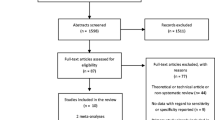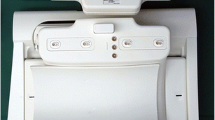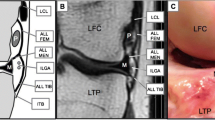Abstract
In order to evaluate the reliability of low-field magnetic resonance imaging (MRI), we examined 22 patients using a 0.2-Tesla magnet unit in comparison with a 1.5-Tesla system. The MRI findings were compared with the intraoperative findings. Concerning the diagnosis of meniscal tears, the gradings of both systems differed only in three cases. The specificity was 97% (both systems), the sensitivity 83% (1.5 T) versus 75% (0.2 T). The sensitivity and specificity for detection of tears of the anterior cruciate ligament were 100% and 75%, respectively, for both systems. The gradings differed only in two cases. In our series we found 6 full-thickness cartilage defects that were all detected with the high-field imaging system. They were missed by the low-field imaging system in 5 cases. The results suggest that both systems are reliable in diagnosing meniscal tears and ruptures of the anterior cruciate ligament.
Similar content being viewed by others
References
Barnett MJ (1993) MR diagnosis of internal derangements of the knee: effect of field strength on efficacy. Am J Roentgenol 161:115–118
Barronian AD, Zoltan JD, Bucon KA (1989) Magnetic resonance imaging of the knee: correlation with arthroscopy. Arthroscopy 5:187–191
Boeve BF, Davidson RA, Staab EV (1991) Magnetic resonance imaging in the evaluation of knee injuries. South Med J 84:1123–1127
Crues JV, Mink J, Levy TL, Lotysch M, Stoller DW (1987) Meniscal tears of the knee: accuracy of MR imaging. Radiology 164:445–448
Crues JV, Ryu R, Morgan FW (1990) Meniscal pathology: the expanding role of magnetic resonance imaging. Clin Orthop 252:80–87
De Smet AA, Norris MA, Yandow DR, Graf BK, Keene JS (1993) Diagnosis of meniscal tears of the knee with MR imaging: effect of observer variation and sample size on sensitivity and specificity. Am J Roentgenol 160:555–559
Donohue MJ, Buss D, Oegema TR, Thompson RC (1983) The effect of indirect blunt trauma on adult canine articular cartilage. J Bone Joint Surg [Am] 65:948–957
Fisher SP, Fox JM, Del Pizzo W, Friedmann MJ, Snyder SJ, Ferkel RD (1991) Accuracy of diagnoses from magnetic resonance imaging of the knee. A multicenter analysis of one thousand and fourteen patients. J Bone Joint Surg [Am] 73:2–10
Gahunia HK, Lemaire C, Cross AR, Babyn P, Kessler MJ, Pritzker KP (1993) Osteoarthritis in rhesus macaques: assessment of cartilage matrix quality by quantitative magnetic resonance imaging. Agents Actions [Suppl] 39:255–259
Glashow JL, Katz R, Schneider M, Scott WM (1989) Double-blind assessment of the value of magnetic resonance imaging in the diagnosis of anterior cruciate and meniscal lesions. J Bone Joint Surg [Am] 71:113–119
Glückert K, Kladny B, Blank-Schäl A, Hofmann G (1992) MRI of the knee joint with a 3-D gradient echo sequence — equivalent to diagnostic arthroscopy? Arch Orthop Trauma Surg 112:5–14
Heron CW, Calvert PTAD (1992) Three-dimensional gradientecho MR imaging of the knee: comparison with arthroscopy in 100 patients. Radiology 183:839–844
Jackson DW, Jennings LD, Maywood RM, Berger PF (1988) Magnetic resonance imaging of the knee. Am J Sports Med 16:29–37
Jerosch J, Castro WHM, Lahm A, Assheuer J (1989) The diagnostic value of MRI in knee joint pathology. Z Orthop 127:661–667
Mesgarzadeh M, Moyer R, Leder DS, Revesz G, Russoniello A, Bonakdarpour A, Tehranzadeh J, Guttmann D (1993) MR imaging of the knee: expanded classification and pitfalls to interpretation of meniscal tears. Radiographs 13:489–500
Mink JH, Levy T, Crues JV (1987) Tears of the anterior cruciate ligament and menisci of the knee: MR imaging evaluation. Radiology 164:445–448
Polly DW, Callaghan JJ, Sikes RA, McCabe JM, McMahon K, Savory CG (1988) The accuracy of selective magnetic resonance imaging compared with the findings of arthoscopy of the knee. J Bone Joint Surg [Am] 70:192–198
Reicher MA, Hartzman S, Bassett LW, Mandelbaum B, Duckwiler G, Gold RH (1987) MR imaging of the knee. Part 1. Traumatic disorders. Radiology 162:547–551
Silva I, Silver DM (1988) Tears of the meniscus revealed by magnetic resonance imaging. J Bone Joint Surg [Am] 70:199–202
Spiers AS, Meagher T, Ostlere SJ, Wilson DJ, Dodd CA (1993) Can MRI affect arthroscopic practice? A prospective study of 58 patients. J Bone Joint Surg [Br] 75:49–52
Stoller DW, Martin C, Crues JV, Kaplan L, Mink JH (1987) Meniscal tears: pathologic correlation with MR imaging. Radiology 163:731–735
Wilson D, Paul PK, Roberts ED, Blancuzzi V, Gronlund-Jacob J, Vosbeck K, Di Pasquale G, O'Byrne EM (1993) Magnetic resonance imaging and morphometric quantitation of cartilage histology after chronic infusion of interleukin 1 in rabbit knees. Proc Soc Exp Biol Med 203:30–37
Author information
Authors and Affiliations
Rights and permissions
About this article
Cite this article
Kladny, B., Glückert, K., Swoboda, B. et al. Comparison of low-field (0.2 Tesla) and high-field (1.5 Tesla) magnetic resonance imaging of the knee joint. Arch Orthop Trauma Surg 114, 281–286 (1995). https://doi.org/10.1007/BF00452088
Received:
Issue Date:
DOI: https://doi.org/10.1007/BF00452088




